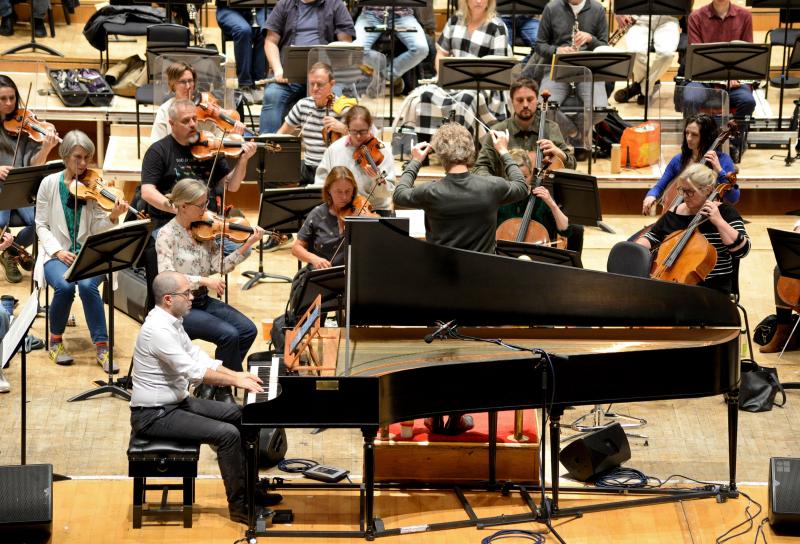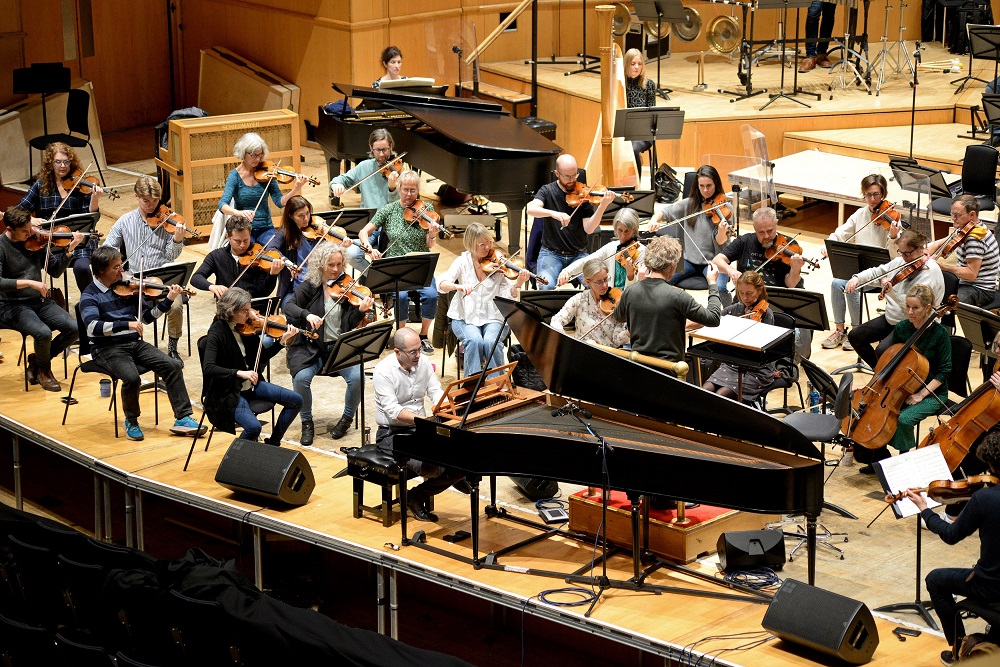Esfahani, RSNO, Søndergård, Usher Hall, Edinburgh review - music meets machine | reviews, news & interviews
Esfahani, RSNO, Søndergård, Usher Hall, Edinburgh review - music meets machine
Esfahani, RSNO, Søndergård, Usher Hall, Edinburgh review - music meets machine
A rare harpsichord concerto premiere followed by a crowdpleaser for orchestra and organ

This was one of those rare occasions when a somewhat diverse collection of pieces knits together into a rather satisfying programme. To start at the end, the Saint-Saëns “Organ” Symphony is a rumbustious crowd pleaser not least because of its theatrical appeal: the lone organist sitting way above the orchestra unleashing the final peroration in a great surge of full-fat romantic harmony.
“Feel how it moves the air”, as the late great Carlo Curley once told me, of the then partially defunct Usher Hall organ. Now in fine fettle, this great civic instrument by Norman and Beard makes light work of Saint-Saëns’ magisterial vision – local organist Michael Bawtree effortlessly juggling the ranks of stops and couplers almost to the point of drowning out the Royal Scottish National Orchestra. To misquote Beecham, we “don’t really care for music, but absolutely love the noise it makes.”
But there’s more to this symphony than just the organ’s overweening contribution. Saint-Saëns is not short of a tune or two, and the wealth of melodic material suggests a symphony considerably longer than it really is – at 36 minutes there is not a moment wasted. One feature of the writing that stood out in this particular concert is the contribution of the woodwind, whose chattering interjections do much to lighten the texture, for here the music found an echo of the piece that started the evening, Stravinsky’s Jeux de cartes.  This is Stravinsky in playful mode, both musically and dramatically. Born of his love of poker, the score was written for a ballet in which the protagonists are dressed as playing cards. The music is fiercely rhythmic, heavily reliant on the motoric drive of a very tightly knit woodwind section. To my ears, this is music that’s too chilly to be lovable, but my impression is that it lies close to conductor Thomas Søndergård’s heart (pictured above by Chris Hart with the RSNO; he opened the season last week with The Rite of Spring), and we could not have hoped for a more impressive or committed performance.
This is Stravinsky in playful mode, both musically and dramatically. Born of his love of poker, the score was written for a ballet in which the protagonists are dressed as playing cards. The music is fiercely rhythmic, heavily reliant on the motoric drive of a very tightly knit woodwind section. To my ears, this is music that’s too chilly to be lovable, but my impression is that it lies close to conductor Thomas Søndergård’s heart (pictured above by Chris Hart with the RSNO; he opened the season last week with The Rite of Spring), and we could not have hoped for a more impressive or committed performance.
Between these two pieces we were treated to one of the most original and mesmerising concertos I have ever heard on this stage. This was the UK premiere of Poul Ruders’ Concerto for Harpsichord, co-commissioned by the RSNO and the Aarhus Symphony Orchestra, a piece that cheerfully upends everything we thought we knew about an instrument firmly anchored in the 18th century. We are accustomed to hearing the harpsichord against a small baroque orchestra, but not against a large symphony orchestra with a lush score, and not making any particular effort to be quiet either. For this reason, Ruders specifies amplification of his solo instrument, acknowledging in his programme note that “period-instrument fundamentalists will be horrified – the mere thought is abominable.”
In the event, the amplification was unobtrusive, to the point that I wondered if it was in fact working, and it certainly did not detract from the extraordinary performance by harpsichord superstar Mahan Esfahani, for whom this concerto was written. The solo part is driven forward by an almost brutal rhythmic momentum, dense chord clusters merging into an almost unearthly sound in which the musical notes are subsumed into an expression of pure percussive energy. The vision that came to my mind was that of a machine grinding music much like stones being crushed in a gravel quarry. If that sounds like an unflattering comparison, it does not take into account the compelling presence of Esfahani at the keyboard, often rising from his seat in sheer exuberance, hands chasing each other up and down the keyboard when not taking the opportunity to tweak one of several buttons controlling the harpsichord sound.  For the most part, the orchestra inhabits a different universe, providing a calm, near-romantic backdrop to Esfahani’s manic energy, though the slower central movement (this at least was a nod to convention) allowed soloist and orchestra to find common ground in a cinematic interlude, a feature of which was the unusual twanging sound from the low strings of a grand piano being plucked. It’s difficult to do justice to a concerto that defies convention as thoroughly as this one, but suffice it to say that it was met with a roar of approval at the end, matched only by an even greater roar of approval for the appearance of the composer on stage.
For the most part, the orchestra inhabits a different universe, providing a calm, near-romantic backdrop to Esfahani’s manic energy, though the slower central movement (this at least was a nod to convention) allowed soloist and orchestra to find common ground in a cinematic interlude, a feature of which was the unusual twanging sound from the low strings of a grand piano being plucked. It’s difficult to do justice to a concerto that defies convention as thoroughly as this one, but suffice it to say that it was met with a roar of approval at the end, matched only by an even greater roar of approval for the appearance of the composer on stage.
Esfahani treated us to an encore, an exquisitely poised Gavotte and Variations by Rameau, which reminded us of the harpsichord’s principal musical constituency. That these two sharply contrasting visions could co-exist so easily in one concert shows that adventurous programming can work when the commitment is as evident as it was on Friday night.
rating
Explore topics
Share this article
The future of Arts Journalism
You can stop theartsdesk.com closing!
We urgently need financing to survive. Our fundraising drive has thus far raised £49,000 but we need to reach £100,000 or we will be forced to close. Please contribute here: https://gofund.me/c3f6033d
And if you can forward this information to anyone who might assist, we’d be grateful.

Subscribe to theartsdesk.com
Thank you for continuing to read our work on theartsdesk.com. For unlimited access to every article in its entirety, including our archive of more than 15,000 pieces, we're asking for £5 per month or £40 per year. We feel it's a very good deal, and hope you do too.
To take a subscription now simply click here.
And if you're looking for that extra gift for a friend or family member, why not treat them to a theartsdesk.com gift subscription?
more Classical music
 Solomon, OAE, Butt, QEH review - daft Biblical whitewashing with great choruses
Even a top soprano and mezzo can’t make this Handel paean wholly convincing
Solomon, OAE, Butt, QEH review - daft Biblical whitewashing with great choruses
Even a top soprano and mezzo can’t make this Handel paean wholly convincing
 Two-Piano Gala, Kings Place review - shining constellations
London Piano Festival curators and illustrious friends entertain and enlighten
Two-Piano Gala, Kings Place review - shining constellations
London Piano Festival curators and illustrious friends entertain and enlighten
 Echo Vocal Ensemble, Latto, Union Chapel review - eclectic choral programme garlanded with dance
Beautiful singing at the heart of an imaginative and stylistically varied concert
Echo Vocal Ensemble, Latto, Union Chapel review - eclectic choral programme garlanded with dance
Beautiful singing at the heart of an imaginative and stylistically varied concert
 Scott, Irish Baroque Orchestra, Whelan, RIAM, Dublin review - towards a Mozart masterpiece
Characteristic joy and enlightenment from this team, but a valveless horn brings problems
Scott, Irish Baroque Orchestra, Whelan, RIAM, Dublin review - towards a Mozart masterpiece
Characteristic joy and enlightenment from this team, but a valveless horn brings problems
 Classical CDs: Voice flutes, flugelhorns and froth
Baroque sonatas, English orchestral music and an emotionally-charged vocal recital
Classical CDs: Voice flutes, flugelhorns and froth
Baroque sonatas, English orchestral music and an emotionally-charged vocal recital
 Kanneh-Mason, Britten Sinfonia, Shave, Milton Court - a grin and a big beaming smile
A pair of striking contemporary pieces alongside two old favourites
Kanneh-Mason, Britten Sinfonia, Shave, Milton Court - a grin and a big beaming smile
A pair of striking contemporary pieces alongside two old favourites
 theartsdesk at the New Ross Piano Festival - Finghin Collins’ musical rainbow
From revelatory Bach played with astounding maturity by a 22 year old to four-hand jazz
theartsdesk at the New Ross Piano Festival - Finghin Collins’ musical rainbow
From revelatory Bach played with astounding maturity by a 22 year old to four-hand jazz
 First Person: Manchester Camerata's Head of Artistic Planning Clara Marshall Cawley on questioning the status quo
Five days of free events with all sorts of audiences around Manchester starts tomorrow
First Person: Manchester Camerata's Head of Artistic Planning Clara Marshall Cawley on questioning the status quo
Five days of free events with all sorts of audiences around Manchester starts tomorrow
 Goldscheider, Brother Tree Sound, Kings Place review - music of hope from a young composer
Unusual combination of horn, strings and electronics makes for some intriguing listening
Goldscheider, Brother Tree Sound, Kings Place review - music of hope from a young composer
Unusual combination of horn, strings and electronics makes for some intriguing listening
 theartsdesk Q&A: composer Donghoon Shin on his new concerto for pianist Seong-Jin Cho
Classical music makes its debut at London's K-Music Festival
theartsdesk Q&A: composer Donghoon Shin on his new concerto for pianist Seong-Jin Cho
Classical music makes its debut at London's K-Music Festival

Add comment